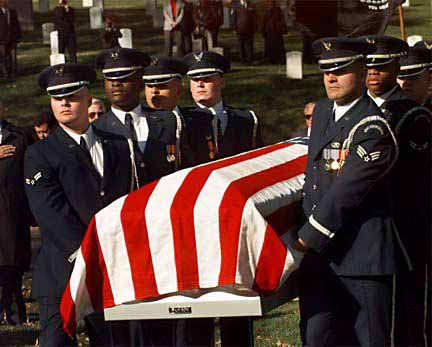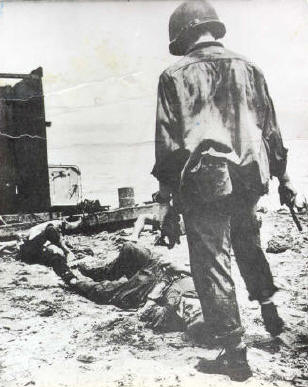






| Website Stats |
Visits from over |
|
Free downloads |
You can now read the material from this website on most electronic devices: -On your computer
Two NEW books from the author of BibleHelp
|
Mortality Rates of American Wars -Part 1
Back

Chapter: 4.06
(Section 4: Fear, Death, and the Fear of Death)
Copyright © Michael Bronson 1997, 1999, and 2000
BibleHelp.org
Summary
An interesting look at the "death statistics" of past American wars. As you will see, the raw numbers don't tell the whole story.
Click Here for a book version of this material
For the ease of reading, I have divided this subject into three chapters. The three chapters cover:
Some interesting history of these wars
Graphs of the mortality rates of American wars
Statistics used to make the graphs
During the Civil War, General Sherman made the profound statement, "War is Hell." Anyone who has actually fought in combat understands that this was probably the most understated comment of the century. There is no "glory" in war. Even when war is totally necessary and we are fighting to defend our country (like in WW2), war is still ugly, sickening, and repugnant.
There are no winners in war, only losers. The "winners" in a war are not determined by who won the battles, but by who lost the least. Even the "winners" suffered tremendous losses. Look at my chapter There are No winners in War for more information about this.
Most wars are senseless, stupid and avoidable. They are a shameful waste of precious human life. If you read my chapter There are No winners in War, you will see that I am not an "antiwar protestor." I believe in a strong military and national defense. History has repeatedly shown us that any country with a weak defense is inviting aggression. I also believe in the unfortunate need to defend the defenseless (when there is solid evidence that wholesale murder and torture is taking place in another country).

General Patton made the historic statement, "I hear a lot of c*** about what a glorious thing it is to die for your country. It isn’t glorious; it’s stupid. You don’t go into battle to die for your country, you go into battle to make the other b****** die for his country."
When we read about death statistics, we usually forget that each soldier killed is a life just like yours and mine. We also forget that every time a soldier is killed, about 12 other people’s lives are profoundly affected. Unfortunately, a key ingredient of winning a war is killing someone else’s father, brother, or husband before he kills you.
The first three graphs (in the next chapter) provide an interesting look at former American wars. As you can see, simply looking at the raw numbers of soldiers killed (graph 1) does not tell the whole story. Graph 2 shows that certain wars have destroyed large portions of our military. Graph 3 compares the number of soldiers killed to the total U.S. population
Another way of comparing the lethalness of a war is to look at the average number of soldiers killed each day (graph 4). This number of course, is only an average. In WW2, for example, the majority of our soldiers were killed in the last year of the war.
There is some guesswork in the creation of these graphs. Determining the beginning and end of a war is not as simple as you would think. Usually, a war is "triggered" by an event, yet it may be days, weeks, or even months before the country decides to go to war. Following are some examples of this problem:
When did the Civil War actually start? South Carolina seceded from the Union on December 20, 1860. Yet, war "officially" began on April 12, 1861 when the Confederates fired on Fort Sumter.
Does war start the day a country is attacked or when Congress "declares war." Pearl Harbor was attacked on December 7, 1941, but Congress didn’t declare war until the next day. (It should be noted that Congress never "declared war" on Korea or Vietnam.)
While some wars erupt quickly, others brew slowly. When a war takes several years to escalate, how do you determine the starting date? Long before the Vietnam War "started," President Truman sent 35 military advisors to Vietnam. By 1963, the numbers increased to 1,500.
On August 2, 1964, a U.S. destroyer was "attacked" in the Gulf of Tonkin. (Records now indicate that parts of the attack were fabricated in order to give us a "Pearl Harbor.") As a result of the attack, the Gulf of Tonkin Resolution was passed. The Gulf of Tonkin Resolution is considered the official beginning of the Vietnam War. (It should be noted that neither the Korean War or the Vietnam War were actually called "wars." They were called "police actions" or conflicts.)
Does the war end when one side says it surrenders or when the Peace Agreement is signed? On August 14, 1945 Japan announced it would surrender. Yet, it took 19 days to hammer out the terms of surrender. The surrender document wasn’t signed until September 2, 1945.
If a major battle takes place after a peace agreement is signed, are the dead considered "war casualties?" The War of 1812 officially ended on December 24, 1814 after the Treaty of Ghent was signed. Unfortunately, 15 days later, the British fleet (unaware the war had ended) attacked New Orleans. Over 1,500 British soldiers died.
When you get to the actual raw numbers in part 3, you will find two groups of deaths: "battle deaths" and "non-battle deaths." The difference between the two is not always as clear as you would think. For example, the following deaths are usually considered "non-battle deaths:"
A soldier is on a training mission in Nevada and he is killed when his helicopter crashes because of mechanical problems.
A soldier is being flown to an on-going battle and is killed when his helicopter crashes a half-mile from the front lines because of mechanical problems.
Six helicopters are flying on a covert mission deep behind enemy lines. The secrecy of the mission requires they fly under very dangerous conditions (very tight formation at night with no lights). Two helicopters crash into each other; killing all on board.
A German U-Boat torpedoes a ship transporting soldiers from the U.S. to England. There are no survivors.
A soldier on the front lines is forced to live in a foxhole for several weeks. He dies from diseases brought on by unsanitary water and living conditions. In some wars, more soldiers have died from disease than from actual battle injuries. In fact, two thirds of the Civil War deaths were from disease.
It’s understandable that military planners don’t want to skew combat statistics with unrelated deaths. Yet, the military deliberately tries to keep "combat deaths" as low as possible in order to hide the true losses from the public.
In my opinion, if it weren’t for the war, most of these people would not have died. Although these people may not have died directly from the hands of the enemy, they definitely died in the service of defending their country in a time of war. Therefore, I have included these numbers in my statistics.
Being captured and held as Prisoner of War (POW) meant different things in different wars. For example, you were 10 times more likely to die as a POW in the Korean War than you were in WW1. Some countries, such as Japan, was notorious for killing its POWs. Other countries, such as Korea, were notorious for its unhealthy living conditions.
Documents discovered after the fall of the Soviet Union has provided some chilling revelations. Not all of our POWs were returned to us after the wars (WW2, Korean War, and the Vietnam War). As it turns out, the Soviet Union took possession of some of our POWs and listed them as dead. Although there is no indication any of them are alive today, documents show some of them lived for decades in Russian prisons.
Except for the past 100 years, direct battle deaths in wars were actually quite low. Wars were not the carnage machines they are today. For the majority of history, most wars were fought with hand-held weapons like clubs, spears, and arrows. Some of the larger and more advanced armies (like the Roman Empire) used larger weapons such as catapults.
Although these weapons were quite deadly, their use didn’t create massive deaths on the battlefield. Most of the deaths in these wars (which were sometimes very high considering the population sizes) were brought on by disease and living conditions. Large concentrations of soldiers created contaminated water and unsanitary living conditions. This, in turn, brought diseases that quickly spread through the crowded camps. Even minor cuts and wounds were often fatal because of infection.
Today, improved sanitary conditions, antibiotics, evacuation helicopters, and mobile medical units have greatly increased the survival rate. If it had not been for the development of high explosives and high-speed delivery systems, war deaths would have dropped substantially.
High explosives have changed everything. A single bomb can kill dozens or hundreds of people. Destruction that used to take weeks can now be done in hours. "Battlefield deaths" have skyrocketed. (Nuclear weapons, of course, can cause far more destruction.) Although technology has greatly reduced secondary deaths, it has greatly increased battlefield deaths.
When high explosives were developed in the late 1800s, many people thought wars would be made obsolete. Many people (including the developers) felt that these highly destructive bombs would deter countries from going to war. They thought nobody would be foolish enough to go into a full war with these types of weapons. Unfortunately, they were wrong.
Other Chapters in this Section
Home
Tell a Friend about this page

